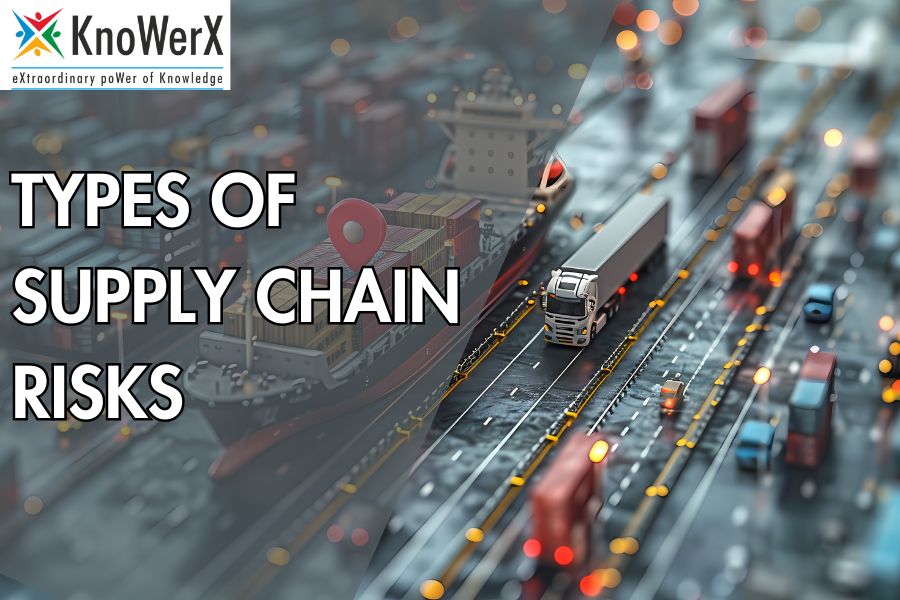Exploring the Various Types of Supply Chain Risks

Types of Supply Chain Risks and Effective Mitigation Strategies | KnoWerX In today’s globalized business environment, supply chains are more complex and interconnected than ever before. Managing these supply chains effectively is crucial for business success, and understanding the types of supply chain risks is a fundamental part of this process. Supply chain risks can disrupt operations, increase costs, and damage a company’s reputation. Therefore, identifying and mitigating these risks is essential for maintaining a smooth and resilient supply chain. Operational Risks Operational risks are among the most common types of supply chain risks. These risks arise from day-to-day operations and can significantly impact the efficiency and effectiveness of a supply chain. Definition and Examples of Operational Risks Operational risks include any disruptions in the processes that move products from suppliers to customers. Examples include equipment failures, supply shortages, transportation delays, and quality control issues. For instance, if a key supplier experiences a machinery breakdown, it can halt production and delay deliveries, impacting the entire supply chain. Causes of Operational Risks The causes of operational risks are diverse. They can originate from internal challenges such as poor equipment maintenance, or external factors like labour strikes at supplier locations. Additionally, natural disasters and accidents can trigger these types of supply chain risks, resulting in unforeseen delays and interruptions. Strategies to Mitigate Operational Risks Mitigating operational risks requires proactive planning and robust strategies. Companies should implement contingency plans to address potential disruptions. This includes having backup suppliers, maintaining safety stock, and using real-time monitoring systems to track supply chain activities. Diversifying suppliers and sourcing from multiple regions can also help reduce the impact of local disruptions. Financial Risks Financial risks are another critical type of supply chain risk that can affect a company’s profitability and stability. Definition and Examples of Financial Risks Among the types of supply chain risks, financial risks specifically relate to economic factors that can destabilize a supply chain’s financial foundation. Common examples include currency fluctuations, interest rate variations, cost overruns, and supplier bankruptcies. For instance, a sudden currency devaluation can escalate the cost of imported goods, thereby squeezing profit margins. Causes of Financial Risks Several factors can cause financial risks. These include volatile currency markets, fluctuating commodity prices, and changes in trade policies. Economic downturns and financial instability in supplier regions can also pose significant financial risks. Strategies to Mitigate Financial Risks To mitigate financial risks, companies can employ strategies such as hedging against currency fluctuations and locking in prices with long-term contracts. Regular financial monitoring and analysis can help identify potential risks early. Building strong relationships with financial institutions and diversifying investment portfolios can also provide a buffer against financial uncertainties. Strategic Risks Strategic risks are types of supply chain risks that arise from changes in the business environment and strategic decisions. Definition and Examples of Strategic Risks Strategic risks include any factors that can alter the competitive landscape or affect long-term business goals. Examples are market changes, new regulations, and shifts in consumer preferences. For instance, a new regulatory policy might require changes in product formulations, affecting the entire supply chain. Causes of Strategic Risks The causes of strategic risks are often external and beyond a company’s control. These include geopolitical developments, technological advancements, and changing market dynamics. Strategic decisions, such as entering new markets or launching new products, can also introduce risks. Strategies to Mitigate Strategic Risks Mitigating strategic risks involves thorough market research and continuous monitoring of the business environment. Companies should stay informed about regulatory changes and industry trends. Developing flexible business strategies and maintaining agility in operations can help adapt to changes quickly. Engaging in scenario planning and stress testing can also prepare companies for potential strategic risks. Environmental Risks Environmental risks are types of supply chain risks that arise from environmental factors and natural events. Definition and Examples of Environmental Risks Environmental risks encompass any natural or environmental factors that can disrupt supply chains. Examples include natural disasters like earthquakes, floods, hurricanes, and climate change impacts. For instance, a hurricane can damage infrastructure and halt transportation, severely affecting supply chain operations. Causes of Environmental Risks Environmental risks are typically caused by natural events and changes in environmental conditions. Climate change is increasing the frequency and severity of extreme weather events, posing significant risks to supply chains. Environmental regulations and sustainability pressures also contribute to these risks. Strategies to Mitigate Environmental Risks To mitigate environmental risks, companies should adopt sustainability practices and build resilience into their supply chains. This includes conducting environmental impact assessments, investing in disaster recovery plans, and diversifying supply chain routes to avoid high-risk areas. Collaborating with suppliers to enhance their environmental resilience is also crucial. Technological Risks Technological risks are types of supply chain risks associated with technology and information systems. Definition and Examples of Technological Risks Technological risks involve threats related to the use of technology in supply chains. Examples include cybersecurity threats, technology failures, and data breaches. For instance, a cyber-attack on a supplier’s system can compromise sensitive information and disrupt supply chain operations. Causes of Technological Risks Technological risks can arise from various sources, including outdated systems, inadequate cybersecurity measures, and rapid technological changes. Human errors and insufficient training on new technologies can also lead to technological risks. Strategies to Mitigate Technological Risks Mitigating technological risks requires robust cybersecurity measures and regular system updates. Companies should invest in secure IT infrastructure and conduct regular security audits. Implementing comprehensive training programs for employees and establishing protocols for technology management can also reduce the risk of technological disruptions. Geopolitical Risks Geopolitical risks are types of supply chain risks that arise from political instability, conflicts, and government actions. Definition and Examples of Geopolitical Risks Geopolitical risks involve disruptions caused by political events or changes in government policies. Examples include trade wars, embargoes, sanctions, and political instability in supplier countries. For instance, a trade war between two countries can lead to increased tariffs, affecting the cost and availability of goods. Causes of Geopolitical Risks The causes of geopolitical
